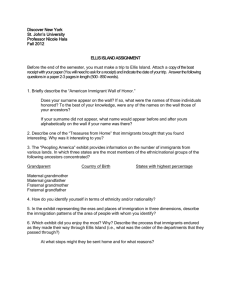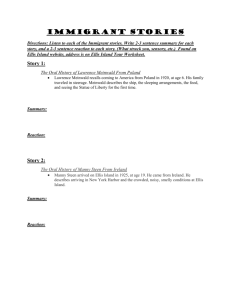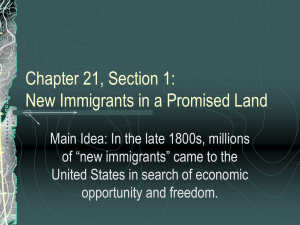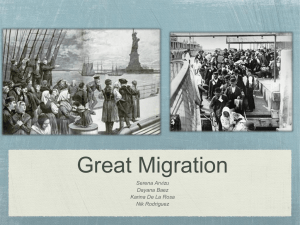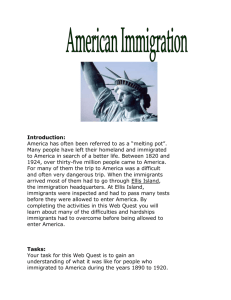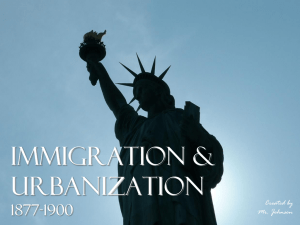Norwegian Immigration to America in the 19th century
advertisement
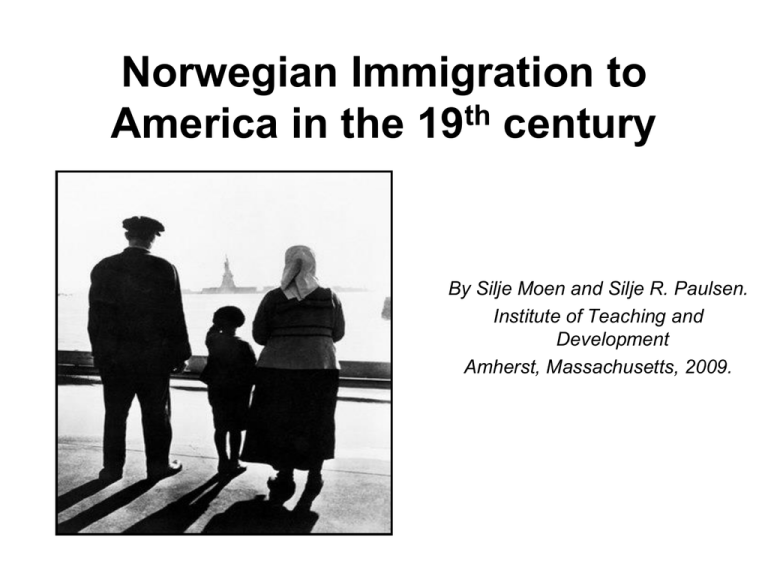
Norwegian Immigration to America in the 19th century By Silje Moen and Silje R. Paulsen. Institute of Teaching and Development Amherst, Massachusetts, 2009. Why this topic? • It is a part of our English curriculum: “know about important features of history (and geography) in the US“ (our translation). • It is an important part of our national history. • Some of the students have relatives who emigrated to America. • We think it is an interesting topic, that will capture and motivate the students. Context • The students are 10th graders, age 15-16 • Homogenous group • The time frame we have set is: – four weeks – three lessons a week – 45 minutes per lesson Objectives and goals Learn about Norwegian immigration to America in the 19th century – Who left? – Why did they leave? – The journey over the Atlantic – Ellis Island – Where did they go? – Daily life for the immigrants Lesson Plan • Starting point: A letter from America. • Brainstorming in class about the subject immigration to America. • Introduction to the topic through PowerPoint led by the teacher. • Reading packet compiled from reading material in the textbook and handouts from teacher. • Visiting Ellis Island online: www.ellisisland.org Students will have to find answers to questions prepared by teacher. …lesson plan continued • Watch documentary “Forgotten Ellis Island” with group discussion afterwards. • Visit from students’ relatives with first hand information/personal account (if possible). • Dramatization: act out a scene from any part of the immigrant experience. • Written work: Choose one of the written assignments and hand in for evaluation. • This will cover our four basic skills of reading, writing, listening and ICT in addition to reading graphs and timelines. Norwegian Immigration to America in the 19th century Historical background • Between 1825 and 1925 about 800.000 Norwegians emigrated to America. • The first organized ship that left Norway for America was called the “Restauration”. • It left Stavanger on July 4th, 1825. • The ship was 18 m long with only 1 m2 for each of the 52 passengers. • The next organized trip was not until 1836 and had 110 passengers. Statistics Who left? • Family units with many children from rural areas. • More men than women. • From the 1860s; younger, unmarried individuals. • Later on; men from the cities. • All social classes were represented, but people from the lower classes were in majority. Why did they leave? • Push: - Religious freedom. - Economical reasons. - Social reasons. - Political reasons. - Increasing population. • Pull: - “Land of opportunity and freedom”. - The Homestead Act, 1862. - Adventure. - Family reunions. - Easier and cheaper travel. - “America letters”. - Emigrant agents and ads. The journey over the Atlantic • In the beginning the journey lasted for three months. • The conditions were rough. • Many got sick and a few even died. • They had to bring their own food, but water and wood was included in the price. • The conditions improved dramatically over the years. • From sail to steam. Statue of Liberty ”Give me your tired, your poor, your huddled masses yearning to breathe free, the wretched refuse of your teeming shore, send these, the homeless, tempest-tossed to me, I lift my lamp beside the golden door!” Emma Lazarus - 1888 The first American Experience • Castle Garden, the first immigration station, received 12 million immigrants from 1820 through 1891. • Over 100 million Americans can trace their ancestors to this early immigration period. • Ellis Island opened January 1st 1892 and is now the most famous immigrant station. Today it is a museum. • About 12 million went through the gates of Ellis Island in the period between 1892 and 1924. • Going through Ellis Island could be both an exciting, scary and difficult experience. • It closed for good in 1954. Ellis Island Ellis Island today Isle of Hope – Isle of Tears Isle of Hope and Isle of Tears • Everyone who came to Ellis Island were hoping for a better life in America… • First and second class passengers passed in a matter of hours and had a good experience… • 355 babies were born in Ellis Island but… • …but not everybody made it through, approximately 2% were excluded from entry. • …while third and steerage passengers had bigger problems passing through the gates. • …3500 people died, 1400 of them children. Where did they settle? Where did they settle continued… • Early Norwegian settlements were in Pennsylvania and Illinois, but moved westward into Wisconsin, Minnesota, and the Dakotas. • Later waves of Norwegian immigration went to the Western states such as Washington and Oregon, and Utah. Norwegian Americans in 2000 Daily life of the immigrants Useful links • • • • www.castlegarden.org www.ellisisland.org www.norwayheritage.com www.mnsu.edu/emuseum/history/mnstate history/norwegian_migration.html • www.spartacus.schoolnet.co.uk/USAEnor way.htm

